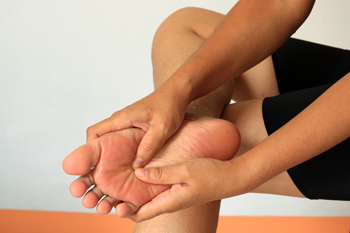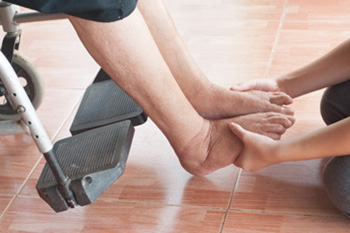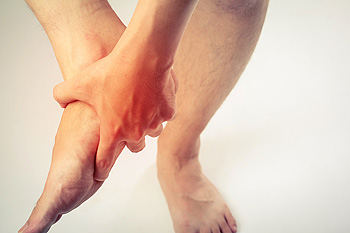Items filtered by date: July 2022
Facts About Peripheral Neuropathy

If you experience a pins-and-needles feeling, a burning sensation, numbness, and tingling, especially in the feet, you may have a condition known as peripheral neuropathy. This is the result of nerve damage that affects the extremities, and is common to diabetics as the result of high blood sugar levels. The risk of peripheral neuropathy increases if you are more than 40 years old, smoke, and drink large amounts of alcohol. A number of other underlying factors can contribute to peripheral neuropathy. Among them are low levels of vitamin B12, underactive thyroid, chronic liver or kidney disease, and inflammation of blood vessels. There is no known cure for peripheral neuropathy, but a number of treatments are available to treat it or lessen its effects. If you believe you may have peripheral neuropathy that affects your feet, it is suggested that you visit a podiatrist to determine the cause and get suggestions for a course of treatment.
Neuropathy
Neuropathy can be a potentially serious condition, especially if it is left undiagnosed. If you have any concerns that you may be experiencing nerve loss in your feet, consult with one of our podiatrists from William Street Podiatry. Our doctors will assess your condition and provide you with quality foot and ankle treatment for neuropathy.
What Is Neuropathy?
Neuropathy is a condition that leads to damage to the nerves in the body. Peripheral neuropathy, or neuropathy that affects your peripheral nervous system, usually occurs in the feet. Neuropathy can be triggered by a number of different causes. Such causes include diabetes, infections, cancers, disorders, and toxic substances.
Symptoms of Neuropathy Include:
- Numbness
- Sensation loss
- Prickling and tingling sensations
- Throbbing, freezing, burning pains
- Muscle weakness
Those with diabetes are at serious risk due to being unable to feel an ulcer on their feet. Diabetics usually also suffer from poor blood circulation. This can lead to the wound not healing, infections occurring, and the limb may have to be amputated.
Treatment
To treat neuropathy in the foot, podiatrists will first diagnose the cause of the neuropathy. Figuring out the underlying cause of the neuropathy will allow the podiatrist to prescribe the best treatment, whether it be caused by diabetes, toxic substance exposure, infection, etc. If the nerve has not died, then it’s possible that sensation may be able to return to the foot.
Pain medication may be issued for pain. Electrical nerve stimulation can be used to stimulate nerves. If the neuropathy is caused from pressure on the nerves, then surgery may be necessary.
If you have any questions, please feel free to contact one of our offices located in William Street in New York, NY, Forest Hills, NY, and Broadway in New York, NY . We offer the newest diagnostic and treatment technologies for all your foot care needs.
Why Live with Pain and Numbness in Your Feet?
Tips for Proactive Foot Care in Seniors

As an individual ages, it becomes even more essential that they are able to maintain proper foot health. This is because if a senior citizen has significantly unhealthy feet, their freedom and independence will be substantially reduced. However, as an individual ages, they also become more susceptible to experiencing foot afflictions. Therefore, senior citizens who want to take extra care of their health should be proactive in maintaining good foot care. One way to do this is to have a set time daily or once each week to examine the feet. The senior can do this by themselves or by asking for the help of a friend. Simply examine the foot for any noticeable problems including redness, swelling, deformations, or complications in the toenails. Scheduling a kind of regular inspection can be helpful for seniors because it enables them to check for any potential problems before they become exacerbated with time. Additionally, to be proactive, seniors can be sure that the shoes that they are wearing are not restrictive or too tight. Wearing properly fitted footwear is essential when an individual ages because ill-fitting shoes can reduce blood circulation and facilitate other troublesome foot afflictions. If you are a senior, be especially diligent when shoe shopping and ask for assistance in finding the best fitting shoes for you. These are just some of many potential proactive foot care tips for seniors. For more, contact a podiatrist.
Proper foot care is something many older adults forget to consider. If you have any concerns about your feet and ankles, contact one of our podiatrists from William Street Podiatry. Our doctors can provide the care you need to keep you pain-free and on your feet.
The Elderly and Their Feet
As we age we start to notice many changes in our body, but the elder population may not notice them right away. Medical conditions may prevent the elderly to take notice of their foot health right away. Poor vision is a lead contributor to not taking action for the elderly.
Common Conditions
- Neuropathy – can reduce feeling in the feet and can hide many life-threatening medical conditions.
- Reduced flexibility – prevents the ability of proper toenail trimming, and foot cleaning. If left untreated, it may lead to further medical issues.
- Foot sores – amongst the older population can be serious before they are discovered. Some of the problematic conditions they may face are:
- Gouging toenails affecting nearby toe
- Shoes that don’t fit properly
- Pressure sores
- Loss of circulation in legs & feet
- Edema & swelling of feet and ankles
Susceptible Infections
Diabetes and poor circulation can cause general loss of sensitivity over the years, turning a simple cut into a serious issue.
If you have any questions please feel free to contact one of our offices located in William Street in New York, NY, Forest Hills, NY, and Broadway in New York, NY . We offer the newest diagnostic and treatment technologies for all your foot and ankle needs.
Some Foot Pain Can Increase at Night

There are several foot maladies that tend to be more painful in the evening. For instance, foot pain from fibromyalgia can increase at night because of a decrease in the anti-inflammatory hormone cortisol. Pain from pinched nerves in the feet and ankles can also worsen in the evening because the pressure placed on these nerves increases at night. Examples of these conditions are tarsal tunnel syndrome in the ankle, and pain in the foot caused by a compressed sciatic nerve in the lower back or leg. Bunions, which are bony protrusions on the joint of the big toe, can become very sore and throb with pain at night as well. Peripheral neuropathy symptoms can worsen at night too due to changes in body temperature and other factors. People experiencing heightened levels of foot pain during the evening may try hydrating, exercising, stretching, massaging, and consulting with a podiatrist for professional treatment.
Foot Pain
Foot pain can be extremely painful and debilitating. If you have a foot pain, consult with one of our podiatrists from William Street Podiatry. Our doctors will assess your condition and provide you with quality foot and ankle treatment.
Causes
Foot pain is a very broad condition that could be caused by one or more ailments. The most common include:
- Bunions
- Hammertoes
- Plantar Fasciitis
- Bone Spurs
- Corns
- Tarsal Tunnel Syndrome
- Ingrown Toenails
- Arthritis (such as Gout, Rheumatoid, and Osteoarthritis)
- Flat Feet
- Injury (from stress fractures, broken toe, foot, ankle, Achilles tendon ruptures, and sprains)
- And more
Diagnosis
To figure out the cause of foot pain, podiatrists utilize several different methods. This can range from simple visual inspections and sensation tests to X-rays and MRI scans. Prior medical history, family medical history, and any recent physical traumatic events will all be taken into consideration for a proper diagnosis.
Treatment
Treatment depends upon the cause of the foot pain. Whether it is resting, staying off the foot, or having surgery; podiatrists have a number of treatment options available for foot pain.
If you have any questions, please feel free to contact one of our offices located in William Street in New York, NY, Forest Hills, NY, and Broadway in New York, NY . We offer the newest diagnostic and treatment technologies for all your foot care needs.
How Children Can Cope With Sever’s Disease

Engaging in a sport can be a rewarding and exciting way for children to spend their time. However, as a growing child engages in increased physical activity, they may be at a greater risk for Sever’s disease. This foot affliction occurs when the growth plate in one or both of a child’s heels becomes swollen. The resulting stress put on the heel can make the back of the foot red and inflamed. Children with Sever’s disease can experience pain and discomfort when putting weight on their heel. This condition occurs most often in children during puberty and growth spurts. Usually children are most affected by this condition during sports season. Although Sever’s disease can be painful, there are a number of steps that you can take to help your child mitigate the condition. For example, a child can stretch before engaging in physical activity, paying particular attention to the hamstrings and calf muscles. Also, you can help your child select a good pair of sneakers to make sure that they are getting the proper amount of support they need in their heels. Sever’s disease is certainly not pleasant for any growing child, so you might consult a podiatrist to help your child manage this condition.
Sever's disease often occurs in children and teens. If your child is experiencing foot or ankle pain, see one of our podiatrists from William Street Podiatry. Our doctors can treat your child’s foot and ankle needs.
Sever’s Disease
Sever’s disease is also known as calcaneal apophysitis, which is a medical condition that causes heel pain I none or both feet. The disease is known to affect children between the ages of 8 and 14.
Sever’s disease occurs when part of the child’s heel known as the growth plate (calcaneal epiphysis) is attached to the Achilles tendon. This area can suffer injury when the muscles and tendons of the growing foot do not keep pace with bone growth. Therefore, the constant pain which one experiences at the back of the heel will make the child unable to put any weight on the heel. The child is then forced to walk on their toes.
Symptoms
Acute pain – Pain associated with Sever’s disease is usually felt in the heel when the child engages in physical activity such as walking, jumping and or running.
Highly active – Children who are very active are among the most susceptible in experiencing Sever’s disease, because of the stress and tension placed on their feet.
If you have any questions, please feel free to contact one of our offices located in William Street in New York, NY, Forest Hills, NY, and Broadway in New York, NY . We offer the newest diagnostic and treatment technologies for all your foot and ankle injuries.


